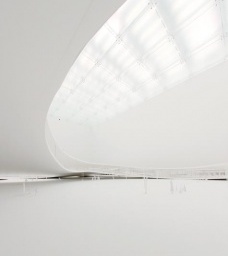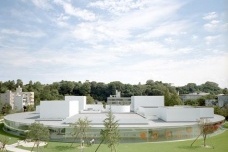SANAA is a team of two architects, Kazuyo Sejima and Ryue Nishizawa. that represents a new style of architecture which emerged in 1995. Rather than focusing on form and design, they begin their process with detailed research of the surrounding community, environment and clients needs; they go through meticulous studies; and draw meaning to form their architectural plans. For instance, they design private houses that are not necessarily for conventional family prototypes Rather, they conceive open architectural programs that are flexible for various real situations.
Non-substantial materials such as glass are often used. By intersecting spaces with the transparent material, they liberate people from pathways, architecturally designed space experience, and perspectives, which had been conventionally pre-programmed by the architects. These basic concepts of SANAA are having a considerable impact on younger generations of architects.
They present a process of maintaining individual styles of living, while forming a field of collective consciousness in the space. The close and intelligent collaboration between the two architects may be also perceived as a process of merging of the two generations through exchanges of perspectives and activating ideas. SANAA’s working method was to lay out the program in the building plan, then raise the spaces into form on this basis. More recently, however, one can sense in curves, free forms and seemingly random orders, the process by which they have moved away from a rigid prescription and are becoming freer. They are driven by a desire to establish flexible relationships with the surrounding environment and site conditions and bring exterior and interior spaces into interaction.
After the success of the 21st Century Museum of Kanazawa, Japan (2004), they developed their architectural language. The composition of the New Museum of Contemporary Art (2007),—a stack of boxes of different sizes randomly shifted off axis—displays a simple lightness of bearing. The building is nevertheless informed throughout with subtle devices aimed at imparting variety to interior lighting and spatial character, in a limited urban setting. The Louvre at Lens (2010), a series of long, narrow volumes connected one to the next in a lightly curving arrangement, also took its departure from the concept of creating a building to respond with fluid intimacy to the shape of its site.
SANAA constructs the basic elements of a design to suit the specific conditions of the project at hand. Of greatest interest in their work, however, are the provocative relationships they provide—between interior and exterior, or among interior spaces—in order to empower the user creatively as the building’s chief participant. SANAA practices the aesthetics of “constructing relationships” in a radical form.
This exhibition will present most of their works through 12 models and 20drawings. Each model is not a conventional architectural model but more a conceptual sculpture.
SANAA design the installation as a new exhibition stenography .One of the highlights of the exhibition is a 1/20 scale model of the Rolex Learning Center which will be installed in the atrium.
notes
1
Curatorial text of the Exhibition “ Sejima Nishizawa / SANAA: flexibility, transparency, amplitude ”. Instituto Tomie Ohtake, São Paulo, 14 of August to 28 of September of 2008.
about the author
Yuko Hasegawa, has been chief curator of the Kanazawa Contemporary Art Museum, teacher of history of the art in Tokyo National University of Fine Arts and Music, and has organised a number of pioneering exhibitions. Hasegawa curates the 7th International Istanbul Biennial.
Yuko Hasegawa, Tokyo Japan





